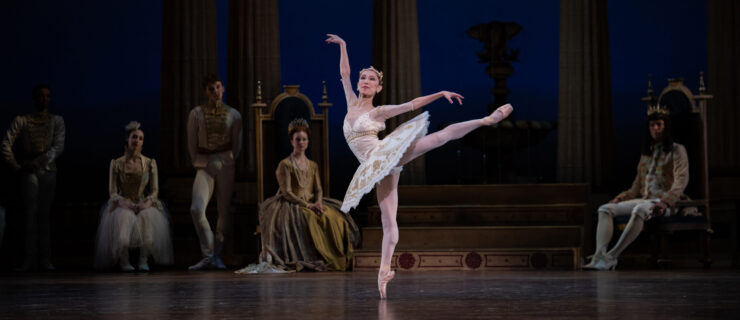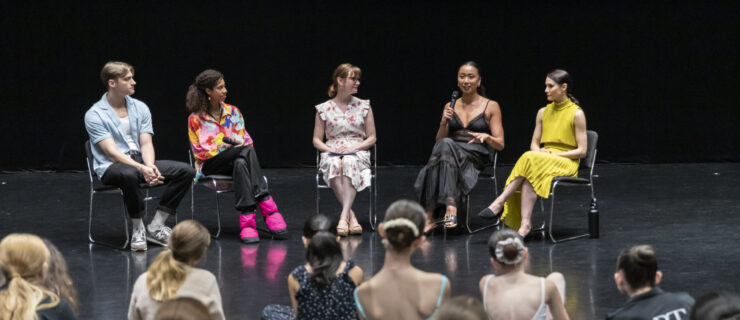Best of Both Worlds: Company-Affiliated BFA Programs Provide Professional Experience and a College Degree
This story originally appeared in the October/November 2014 issue of
Pointe.
Informal connections between BFA programs and professional troupes have been around for decades. But in the last dozen years, some companies and universities began formalizing their relationships, creating joint BFA/trainee programs that provide enrollees both significant pre-professional experience and a four-year degree. In a time of shrinking job opportunities and rising tuition costs, that makes sense.
Maggie Wright Tesch, the University of Utah’s liaison with Ballet West in Salt Lake City (where she formerly danced), explains that combined BFA/pre-professional programs give dancers more settings to train in as well as “a college education, a plan B, because a career can end with one injury.”
Among the advantages, Tesch continues, is that students have two sets of coaches, as well as twice the stage time as a regular trainee. University summer intensives provide experience and credits toward a four-year degree. While the workload is intense, such programs tend to be small and are often flexible.
Still, they’re not for the faint of heart. Prospective students often audition for the company’s trainee program as well as the university’s dance department. They must be admitted to the school’s academic program and fulfill its basic education graduation requirements. Additionally, with few job openings each year, their chances of being hired by the affiliated company after graduation are small. That can be a source of disappointment—but also spur the dancer’s strength and creativity.
Essentially, joint BFA/trainee programs hedge participants’ bets, increasing their time in the studio and on the stage, exposing them to a wide array of choices inside and outside of dance and providing a college degree. While the demands are great, so is the potential payoff. Pointe spoke with three professional dancers who graduated from joint programs. Not all of them received company contracts, but all were pleased with the quality and flexibility of their educational experience.
Kimberly Ballard: Ballet West and University of Utah

Kimberly Ballard in Ballet West’s The Nutcracker
Luke Isley, Courtesy Ballet West
Ballet West corps artist Kimberly Ballard, 26, was not focused on getting into BW when she was applying to colleges. But after she enrolled at the University of Utah, she became a sort of guinea pig for its joint program with the company. After getting her BFA, she continued into U of U’s MFA program—at the same time, she became a BW trainee.
Ballard epitomizes the hard work and planning so helpful to joint-program students, who undertake long days filled with department and trainee classes and rehearsals, as well as academic courses. Because she’d passed several high school AP exams, Ballard placed out of some requirements. She also took academic classes at a community college in the summer, gaining additional college credits in her “downtime,” thereby saving on tuition. By pursuing her MFA, she set herself up for a teaching career.
Though her traineeship with BW undoubtedly shaped Ballard’s performance quality and technique, the university program provided variety. “I did exchange programs in the Basque region of France and with the State Ballet School of Berlin,” she says. As a member of the university’s highest-level repertory company, Utah Ballet, she performed not only in a piece that involved “unitards and bungee cords” but, 20 minutes later, as Aurora. Meanwhile, she danced corps roles in BW’s productions of Swan Lake, Sleeping Beauty and Chaconne.
“For me,” Ballard says, “the joint program worked out very well.” She joined BW II after graduation. Now, in addition to being a company member, she’s putting her degree to use as an adjunct assistant professor at the university.
Michael Montgomery: Alonzo King LINES Ballet and Dominican University of California

Alonzo King LINES Ballet’s Michael Montgomery
RJ Muna, Courtesy Alonzo King LINES Ballet
Michael Montgomery, a dancer with Alonzo King LINES Ballet, had always wanted to dance with the San Francisco–based company. “I saw their world-famous calendars,” he says, “before I knew of LINES or the Dominican University/LINES Ballet BFA program.” Even in still photos, “the artists showed nothing less than excellence.”
Montgomery’s initial step, however, was to enroll in The Ailey School’s certificate program at age 17. “That was the first time I understood the meaning of technique,” he says. But he felt he was being trained to blend in—”An important art to learn,” he says. “It just did not make me feel alive.”
Montgomery reached out to Dominican/LINES BFA director Marina Hotchkiss. “I explained to her that I do not want to live in a box of dance, but rather in a world of endless possibility,” he says. King, he adds, is “opposed to cookie-cutter dancers.” Though LINES Ballet has a non-degree trainee program, Montgomery never considered it. “Schooling and college were always very important to me,” he says.
He became a Dominican/LINES BFA student in 2008. And though his days were long, they were also rewarding. “I had dance classes in many vernaculars from 9 am to 2:30 pm,” he says, “and academic classes until 10 pm some days.” He particularly enjoyed his religion and philosophy classes, and says that, like the LINES faculty, his Dominican professors “believe there is no plateau of knowledge.” King, who taught a number of Montgomery’s classes, offered him a company contract his junior year, allowing him to finish his BFA on the side. The experience, Montgomery says, was “beyond worth it.”
Kyoko Ruch: Richmond Ballet and Virginia Commonwealth University

Kyoko Ruch’s traineeship with Richmond Ballet counted towards her degree at VCU.
Ruth Judson, Courtesy Gin Dance Company
Kyoko Ruch—a self-described naïve bunhead in high school—only wanted to focus on dancing when Richmond Ballet offered her a traineeship in 2004. But when her family learned of the company’s joint program with Virginia Commonwealth University, they talked her into doing both. Two years later, she became an RB apprentice and dropped the VCU program because her work schedule left no time for coursework.
When Ruch auditioned for the main company, however, she was turned down. “I was disappointed,” says Ruch, “but I wasn’t lost, because I had VCU’s program to go back to.”
In fact, not getting into a ballet company (she auditioned for more than one) proved a blessing. In her final two years at VCU, she was able to take some modern and choreography courses. “Most ballet companies now do a lot of contemporary work—and I didn’t really have any idea how to move that way,” she says. “With the modern training, we danced more conceptually, which actually aided my ballet technique.”
Choreography and improvisation classes meant even more to her. “As a ballet dancer, I just wanted to do what I was told,” she says. “Choreography sparked my creativity.” She received her BFA in 2010 and is currently teaching and performing with two DC-area contemporary troupes, Company Danzante and Gin Dance Company. Last year she was chosen as Company Danzante’s first choreographer in residence. Though she originally expected to put off college, she’s glad it didn’t work out that way. “I transformed into another creature.”





